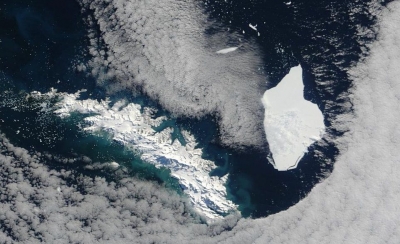
Satellites have been closely monitoring the movement of the world’s largest iceberg, A68A, since it broke off from the Larsen C ice shelf on the east coast of the Antarctic Peninsula in 2017. Measuring 4,200 sq.km. in size, it had been slowly inching north until 2020, when an ocean current quickly propelled it into the Southern Atlantic Ocean and was set on a collision course with a sub-Antarctic island called South Georgia in South Atlantic Ocean. Mid- December, when it was about 75 km from the island, it split into two, as scientists had predicted earlier. The new iceberg, named A68D, moved further away from A68A, while the latter marched on. It is common for icebergs to fracture when they are under the influence of the ocean currents. In the last three years, chunks of A68A have broken off creating icebergs A68B and A68C. But what is worrying is the impact the iceberg could have on the South Georgia island, which is a haven for millions of penguins, seals and whales.
This has prompted a team of scientists at the British Antarctic Survey to set off on a research mission this month to find out more about the giant iceberg A68A and the risks it poses to the island.
What is an iceberg? Why does the berg A68A matter?
What is an iceberg?
An iceberg is ice that broke off from glaciers or ice shelves or larger icebergs and is floating in open water. This process of breaking off is called calving. To be classified as an iceberg, the height of the ice must be greater than 16 feet above sentenced the thickness must be 98-164 feet, according to their agency National Oceanic and Atmospheric Administration. Icebergs are made of frozen freshwater. Most of the mass of an iceberg lies below the surface of the water, which is dangerous to ships. The North Atlantic and the cold waters surrounding Antarctica are home to most of the icebergs on Earth.
Why are scientists worried?
- South Georgia is home to millions of gentoo, macaroni, and king penguins and sea lions, nesting albatrosses, and petrels. A small population of endangered blue whales is also found here. The island is also incredibly diverse on the seabeds, harbouring molluscs, crustaceans, sponges and other life. It’s a diversity almost equivalent to the Galapagos, say scientists.
- Researchers fear that as the iceberg A68A closes in on the wildlife-rich island, it could grind into the seabed, disrupting underwater ecosystems.
- If the iceberg gets lodged in the island’s shoreline it could stay there for years and decades. That would cut access to the ocean for penguin, and seal parents, who make trips into the water to collect fish and krill for their young.
- The waters around South Georgia are about 4 degree C, but in the vicinity of the iceberg the temperature could fall to a couple of degrees more. It could lead to the release of billions of tonnes of fresh water from iceberg into the region, ** which can devastate the ecosystem.
Is global warming a reason?
Though warming did not directly cause the break off of iceberg A68A, scientists draw our attention to its influence on ice shelves in the region. They found that about 60 % of the ice shelf area in Antarctica is vulnerable to a process called hydrofracturing, in which meltwater seeps into the shelves’ crevasses (cracks in glaciers), some of which are hundreds of metres deep, and trigger collapse. The collapse of Larsen B iceberg in the northern tip of the Antarctic peninsula in 2002 is attributed to hydrofracturing. Warming caused meltwater ponds to form on the surface of Larsen B, and water percolating down through the ice led to the shattering of the shelf into icebergs. More ice shelves could disintegrate in similar fashion, warn scientists. .
The Antarctic Peninsula is one of the fastest warming regions on Earth, and the ice shelves along its eastern coast have been apart. The Larsen A ice shelf, near the northern tip of the peninsula, collapsed in 1995. Its neighbour Larsen B followed suit in 2002. The Larsen C, is the largest of the three, broke off in 2017.
Picture Credit : Google




